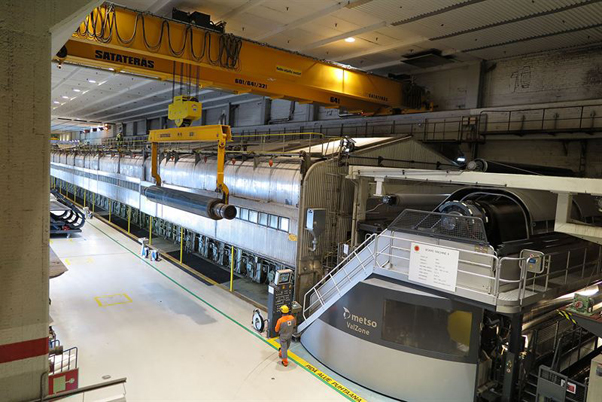Stora Enso Imatra Web Inspection/Monitoring Upgrade Boosts Quality of BM 4
![]() Print this Article | Send to Colleague
Print this Article | Send to Colleague
Stora Enso Imatra Mills, Finland, has installed the Procemex, Finland, web inspection and web monitoring system to better investigate the root causes of web breaks, reduce the number of breaks, and increase production efficiency. Stora Enso Imatra Mills is the largest manufacturer of liquid packaging board in the world
As Stora Enso notes, consumer packaging board used in contact with food and liquids must meet strict quality requirements set for food safety. Also, no flavors can dissolve from the board into food products, and the products must be first-rate in terms of visual cleanliness.
For several years, systems supplied by Procemex have been used in Stora Enso's No. 4 board machine (BM 4) to indicate any defects in board quality and to reduce web breaks. In March 2016, Stora Enso Imatra Mills made a system modernization investment to improve the quality of food packaging board and increase the efficiency of the board machine.
"We compared three different suppliers and ended up with Procemex, first of all, because we have had positive experiences with the previous system and, secondly, because we were able to upgrade the previous system – without needing to acquire a completely new one. We also investigated what benefits we can gain from the upgrade. In the end, the decision was an easy one; after all, we obtained a wholly new system by simply upgrading the old one," said Riku Suurnäkki, production manager of BM 4.
"Both web break and web inspection/defect detection systems are critical elements to be able to operate these machines—web inspection in terms of the final cleanliness and the web break system in terms of production efficiency. If we encounter any problems with efficiency, the web break system allows us to identify the root cause of breaks, enabling us to resolve, or even eliminate, the problems," Suurnäkki explained.
Stora Enso Imatra Mills defined new locations for cameras, together with machine operators, and, now, cameras indicate the locations where pulp starts to pile up. "Of course, it is essential to listen to users," Suurnäkki said. "The new system became a necessity after we identified that we need to improve the classification of defects and the usability of the system. The previous system was unable to reliably classify a certain common defect, and there were situations in which defects in board ended up in our plastic coating," he added.
The newly upgraded Procemex cameras have a significantly higher resolution, defects are now classified more closely, the detection of defects is now more visual, and the system is easier to configure for each user.
"We can better detect any dirt and impurities," said Vesa Koskinen, system specialist at Efora, who is responsible for the maintenance of the BM 4 system.

"On our part, the project did not get off to a textbook start, and we were forced to speed up the process. Procemex did an excellent job, even though the order-delivery schedule was very tight. The installation period was also tightly regulated and brief, but Procemex was able to ensure the resources required," said Suurnäkki. "Commissioning, adjustments and links to mill systems – everything was done on time.
"The experience we have had so far indicate that the detection of defects is now much more visual than in the previous system, and the classification of defects has improved. Operators have already given us direct, positive feedback, saying that the image quality is on a completely different level and, therefore, there are fewer web breaks," Suurnäkki pointed out.
"When acquiring new systems, usability and maintainability are among the most important criteria to keep our expensive machines and systems up and running. Cameras need to remain clean and the image quality must be high. The supplier must be quick and easy to reach," Suurnäkki continued, listing the criteria set for the new system.
Koskinen explained that "the new system improved overall reliability. We acquired new PCs and upgraded our cameras. Shifting to the new system was a simple process. These Procemex Pinhole cameras are excellent, and they practically require no cleaning. The Pinhole cameras are in challenging locations, where pulp keeps flying every which way, but they are easy to keep clean. The new Procemex cameras offer an HD quality, the images they produce are on a whole different level, and lighting has been improved by using new Procemex LEDs. These new lights are much easier to control than the old ones. It is easy to call Procemex whenever we need help, and it quickly responds to our questions."
Stora Enso is using the Procemex remote reporting system, which offers preventive information, for example, about system performance, camera image quality, the operation of IT hardware, and backups—it is a maintenance tool. The system produces monthly reports, creating comprehensive information about maintenance and raising a need for various tasks. "Procemex has very short delivery times for spare parts, of course with the help of the preventive remote reporting system," Koskinen said.
Stora Enso Imatra Mills is the largest manufacturer of liquid packaging board in the world. Imatra Mills consists of two mill units—Kaukopää and Tainionkoski. Together, these units employ approximately 1,000 people. The annual capacity of Imatra Mills is more than 1 million metric tons of board and paper. More than 90% of production is exported. The company's main market areas are located in Europe, while Southeast Asia forms another significant region.


